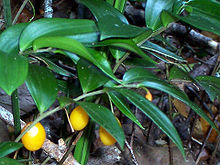Luzuriageae
| Luzuriageae | ||||||||||||
|---|---|---|---|---|---|---|---|---|---|---|---|---|

|
||||||||||||
| Systematics | ||||||||||||
|
||||||||||||
| Scientific name | ||||||||||||
| Luzuriageae | ||||||||||||
| Benth. & Hook. |
The Luzuriageae are a tribe in the family of the Inca lily plants ( Alstroemeriaceae) from the order of the lily-like (Liliales). The distribution area of the only two genera with about five species is disjoint , so the species are distributed in widely spaced areas, there are species from southern South America ( Chile , Argentina ) to the Falkland Islands and in southeastern Australia and New Zealand .
description


Vegetative characteristics
They are upright or climbing, herbaceous plants or upright or climbing shrubs . They often form rhizomes .
The alternate and two lines arranged leaves are simple. Petioles are present or absent. The underside of the linear, lanceolate or ovate leaf blade is directed upwards (resupinate).
Generative characteristics
The flowers are usually solitary or in terminal to lateral zymous inflorescences . The relatively small, hermaphrodite flowers are radial symmetry and threefold. The six free bloom bracts are of the same shape and monochrome ( perigone ). There are six free, fertile stamens . Three carpels have become a top permanent ovary grown.
There are berries formed.
Systematics and distribution
The Luzuriageae tribe has a disjoint area in the southern hemisphere . Drymophila is only found in Australia including Tasmania . In the genus Luzuriaga , two species have a distribution area from south-central Chile to Tierra del Fuego and from southern Argentina to the Falkland Islands ; one species is native to New Zealand .
The genus Luzuriaga was previously classified in the family of Smilacaceae and Drymophila in the Convallariaceae or Liliaceae . Molecular genetic studies have led to the fact that the family boundaries within the order of the lily-like (Liliales) have shifted significantly. The former Luzuriagaceae Lotsy family (published in Lectures on Botanical Tribal History , Volume 3, 1911, p. 760.) became the Luzuriageae Benth tribe . & Hook. f. demoted and incorporated into the Alstroemeriaceae family . The Tribus Luzuriageae was drawn up in May 1874 by Andrey Nikolayevich Beketov in Kurs Bot. , 2, p. 210 or George Bentham and Joseph Dalton Hooker in Revisio Generum Plantarum: ... , Volume 3, April 14, 1883, pages 749, 751 .
In the tribe Luzuriageae there are only two genera with six species:
-
Drymophila R.Br. : They are upright, not climbing, herbaceous plants. Their style is deeply divided. There are only two types:
- Drymophila cyanocarpa R.Br. : It occurs from southeastern New South Wales to Tasmania .
- Drymophila moorei Baker : It occurs from southeastern Queensland to northeastern New South Wales.
-
Luzuriaga Ruiz & Pav. Nom. cons. (Syn .: Enargea Banks ex Gaertn. ): Your stylus is not divided. It has a disjoint area. There are four types:
- Luzuriaga marginata (Gaertn.) Benth. & Hook. f. : It occurs in southern Chile, southern Argentina and the Falkland Islands .
- Luzuriaga parviflora (Hook. F.) Kunth : It occurs in New Zealand .
- Luzuriaga polyphylla (Hook.) Macbr. (Syn .: Luzuriaga erecta Kunth ): It occurs only in southern Chile.
- Luzuriaga radicans Ruiz & Pav .: It occurs from south-central to southern Chile and in southern Argentina.
The following is no longer included in the genus Luzuriaga :
- Luzuriaga laxifolia Hallier f. → Geitonoplesium cymosum (R.Br.) A.Cunn. ex R.Br. (Asphodelaceae)
Note: There is also a genus of birds Drymophila Swainson 1824 in the ant bird family (Thamnophilidae).
swell
- The luzuriagaceae in the family of Alstroemeriaceae in APWebsite . (Sections Description, Distribution and Systematics)
- The Luzuriagaceae family at DELTA by L. Watson & MJ Dallwitz. - here me four genera. (Section description)
Individual evidence
- ↑ a b The Angiosperm Phylogeny Group: An update of the Angiosperm Phylogeny Group classification for the orders and families of flowering plants: APG III. In: Botanical Journal of the Linnean Society. Volume 161, No. 2, 2009, pp. 105-121, doi: 10.1111 / j.1095-8339.2009.00996.x .
- ↑ The Angiosperm Phylogeny Group: An update of the Angiosperm Phylogeny Group classification for the orders and families of flowering plants: APG IV . In: Botanical Journal of the Linnean Society. Volume 181, No. 1, 2016, pp. 1-20, doi: 10.1111 / boj.12385 .
- ↑ The luzuriagaceae in the family of Alstroemeriaceae in APWebsite .
- ↑ Luzuriageae at Tropicos.org. Missouri Botanical Garden, St. Louis, accessed March 23, 2020.
- ↑ a b c d e f Rafaël Govaerts (Ed.): Alstroemeriaceae. In: World Checklist of Selected Plant Families (WCSP) - The Board of Trustees of the Royal Botanic Gardens, Kew . Retrieved March 23, 2020.
